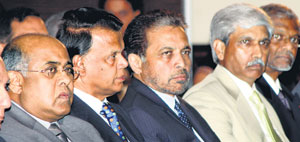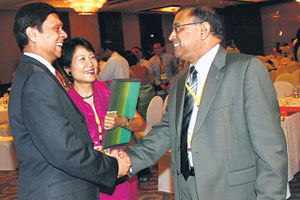 |
| Businessmen and diplomats. Pix by J.Weerasekera |
Many industry leaders, government officials and donor agencies, speaking at the session titled “Revival of the East, Challenges and Opportunities” at the Sri Lanka Economic Summit 2008 this week said that the Eastern province is a promising area for investment.
Ashraff Omar, CEO of Brandix speaking at the session said that the recently-cleared-of LTTE-control province has an employable population of 0.5 million. The current average monthly income in the area is Rs 2,900 while the expenditure is Rs 3,000. Omar said the minimum wage in the apparel industry is Rs 7,000, pointing out that itself is doubling their monthly income. The availability of skilled labour in the East is low but Mr Omar was confident that they can be trained within 60-90 days.
 |
| All smiles: The Treasury Secretary, the Central Bank Governor and the World Bank Country Director. |
He said that initially they will provide employment for about 400 individuals “But if things work out, we will be able to raise it to 2000.” Mr Omar added that if the Americans can build bridges in Arugam Bay then the private sector should also chip in. “If the private sector puts its mind to it, it will be nothing,” he said, adding that the tax holidays offered to investing in the region is “fantastic”.
Answering questions on the political affiliations of the potential employees, he said it is of no concern to them as long as the quality of life in the area goes up. Director of the Hayleys Group Rizwi Zaheed also spoke of the increased investment his company is engaging in, in the province. “Entire agricultural practices in the area are frozen in time,” he said, adding that Hayleys is working on increasing paddy production, mechanizing agricultural practices to achieve higher yield and increase productivity. A Public-Private Partnership (PPP) with USAID is underway to introduce new crops such as pickles, gherkins and pineapple to the Eastern farmers. Currently 120 farmers are part of the programme with plans to increase the number to 400. Hayleys will help the farmers gain access to global markets that Hayleys has access to, including McDonalds. One acre of gherkin can generate approximately Rs 100,000, Mr Hameed said adding that it is important to create confidence in the farmers that agriculture can be productive.
Governor of the Eastern Province Rear Admiral Mohan Wijewickrama said that at present nine milk processing centres and 14 milking centres are to be established, in an effort to raise the dairy industry in the province to what it was before trouble began.
Rebecca Cohn, Mission Director of USAID said, “The most important and significant step in the development of the region is private sector involvement” adding that USAID is involved in a number of PPPs, with USAID being the public partner.
Former BOI chief Lakshman Watawala criticized the tax holidays being offered to only BOI companies stressing that a level playing field must be created. Pointing out that Trincomalee is a city with a lot of potential, with three major organisations, namey the Tokyo cement facility, the Prima facility and the LIOC facility in operation, he said that the authorities must “think big” adding that if there is the same will power to develop Trincomalee as there is to develop Hambantota, it will be a financial paradise. (LP).
Lighter moments at the Summit
 JVP Leader Somawansa Amarasinghe, usually a firebrand, seemed subdued, flustered and even intimidated by the presence of business leaders when he spoke at the Sri Lanka Economic Summit 2008 on the peace process and what is acceptable to the JVP. JVP Leader Somawansa Amarasinghe, usually a firebrand, seemed subdued, flustered and even intimidated by the presence of business leaders when he spoke at the Sri Lanka Economic Summit 2008 on the peace process and what is acceptable to the JVP.
“The discussion with Amarasinghe will be interesting” one delegate was overheard telling another over lunch – before the JVP’s contribution. He was probably disappointed with the lacklustre presentation of the JVPer whose hands appeared to be shaking while he quoted from a book during the panel discussion.
Meanwhile after listening to Treasury Secretary P.B. Jayasundara paint a picture of a prosperous Sri Lanka with an all time record low in unemployment, reduction in poverty and the highest ever investment on infrastructure, a business woman was overheard telling a colleague “They seem to be talking about an entirely different country,” she said with a cynical smile.
The general feeling among the participants at the summit was that the sessions and the presentations were rushed through, with not enough time allocated for each session to be explored and understood properly.
“They should have cut down on the number of sessions a day and given more time for each speaker,” a participant was overheard saying.
(LP) |
| |
SAARC Chamber says region needs to focus on logistics and infrastructure
The SAARC Chamber of Commerce and Industry says the region needs to focus on logistics and infrastructure, for regional trade growth.
Speaking this week at the Sri Lanka Economic Summit, organised by the Ceylon Chamber of Commerce, the President of the SAARC Chamber of Commerce, Tariq Sayeed, said regional trade agreements will not give expected benefits unless coupled with logistics and infrastructure developments. “No matter how much concessions are provided, trade cannot move in the region without supporting infrastructure,” said Mr Sayeed. The Chamber points out that road, rail, air and sea transport facilities need to be improved within the region for regional trade to grow.
“It is very difficult to transport cargo in the region either by sea, air or land. It is much easier to send goods to the US and the EU than for us to trade among ourselves. So that is the reason why regional trade is low,” said Mr Sayeed.
South Asian internal trade, despite the existence of SAARC and a South Asia free trade agreement, is still less than 5% of total regional trade with the rest of the world. This is much lower than the internal trade seen in other regional blocs such as ASEAN (Association of South East Asian Nations) and the EU (European Union). Internal trade in the ASEAN bloc is around 25% while internal trade in the EU is about 66% of total trade.
The Chamber says trade facilitation at government level is crucial for improving regional trade. “Making cross border trade easier is very important for the South Asian region because of the way the countries are situated. For instance, India has common borders with most of the other countries like Pakistan, Bangladesh and Nepal. So for trade to go across the region, cross border trade must be allowed. Customs and other border controls must be adjusted to allow trade to cross between countries,” Mr Sayeed added.
The Chamber says private investments in areas like shipping also needs to be encouraged to improve trade. “We need to encourage businesses in our region to invest in areas like shipping. This is very important for not just regional trade but also to develop trade with the rest of the world. So governments need to consider what incentives or encouragements they can give to the private sector, to pull-in investments in shipping,” the SAARC chamber chief said.
Net those FDIs
The SAARC Chamber says the region has also not made use of opportunities presented by foreign direct investments (FDI). “The role of FDI in economic development has been neglected in our region because of protectionist policies. But this is the best way to attract not just capital but also new technologies,” said Mr Sayeed.
He said China has outpaced South Asian countries fuelled by FDI inflows.
“In the 1950s, exports of both China and India were around US$ 550 million worth. By now China’s exports are worth over one trillion dollars. India’s exports are still around US$ 140 billion. This difference is mainly due to FDI. China’s open door policy brought in huge amounts of FDI and helped transform China into an economic giant in a very short time,” he added.
Brand it
The SAARC Chamber is also calling on SAARC governments and private sector to invest in branding and marketing.“The region has many opportunities but one problem is that people don’t know about these. There is a huge information gap even within the region. So there is a need to raise awareness and also to invest in branding,” said Mr Sayeed. Investing in brand building, he believes, will increase returns to the region and will also establish the region for quality products.
Help each other
The SAARC Chamber has also identified a number of areas for regional cooperation. These include textile and garments, energy, tourism, plant and food processing, rubber and rubber goods, fisheries and IT.
“Different countries in our region have build expertise in different areas and there are complementarities. If we can share the experiences, technology and expertise we can help each other,” said Mr Sayeed.
|
|



 JVP Leader Somawansa Amarasinghe, usually a firebrand, seemed subdued, flustered and even intimidated by the presence of business leaders when he spoke at the Sri Lanka Economic Summit 2008 on the peace process and what is acceptable to the JVP.
JVP Leader Somawansa Amarasinghe, usually a firebrand, seemed subdued, flustered and even intimidated by the presence of business leaders when he spoke at the Sri Lanka Economic Summit 2008 on the peace process and what is acceptable to the JVP.